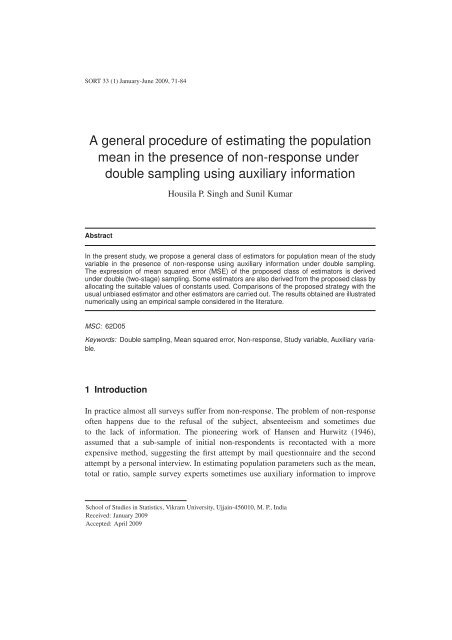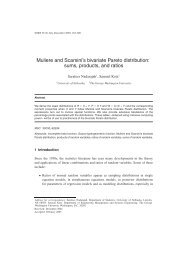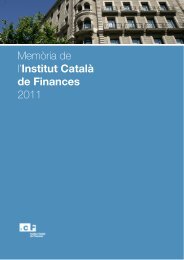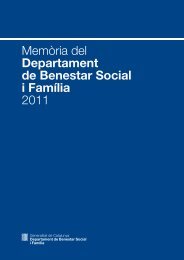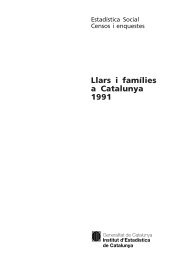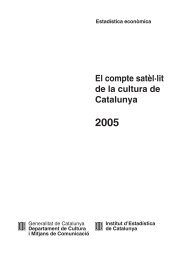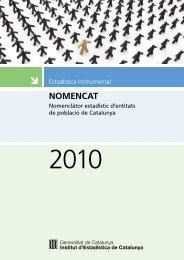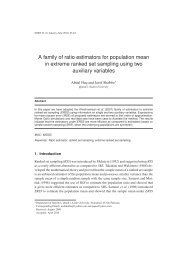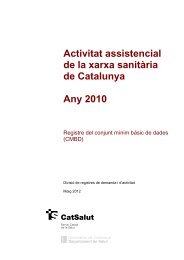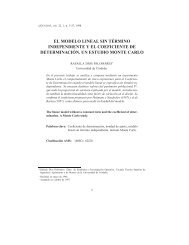Housila P. Singh and Sunil Kumar - Idescat
Housila P. Singh and Sunil Kumar - Idescat
Housila P. Singh and Sunil Kumar - Idescat
You also want an ePaper? Increase the reach of your titles
YUMPU automatically turns print PDFs into web optimized ePapers that Google loves.
Statistics & Operations Research TransactionsSORT 33 (1) January-June 2009, 71-84ISSN: 1696-2281www.idescat.net/sortStatistics &Operations Researchc○ Institut d’Estadística de CatalunyaTransactionssort@idescat.esA general procedure of estimating the populationmean in the presence of non-response underdouble sampling using auxiliary information<strong>Housila</strong> P. <strong>Singh</strong> <strong>and</strong> <strong>Sunil</strong> <strong>Kumar</strong>AbstractIn the present study, we propose a general class of estimators for population mean of the studyvariable in the presence of non-response using auxiliary information under double sampling.The expression of mean squared error (MSE) of the proposed class of estimators is derivedunder double (two-stage) sampling. Some estimators are also derived from the proposed class byallocating the suitable values of constants used. Comparisons of the proposed strategy with theusual unbiased estimator <strong>and</strong> other estimators are carried out. The results obtained are illustratednumerically using an empirical sample considered in the literature.MSC: 62D05Keywords: Double sampling, Mean squared error, Non-response, Study variable, Auxiliary variable.1 IntroductionIn practice almost all surveys suffer from non-response. The problem of non-responseoften happens due to the refusal of the subject, absenteeism <strong>and</strong> sometimes dueto the lack of information. The pioneering work of Hansen <strong>and</strong> Hurwitz (1946),assumed that a sub-sample of initial non-respondents is recontacted with a moreexpensive method, suggesting the first attempt by mail questionnaire <strong>and</strong> the secondattempt by a personal interview. In estimating population parameters such as the mean,total or ratio, sample survey experts sometimes use auxiliary information to improveSchool of Studies in Statistics, Vikram University, Ujjain-456010, M. P., IndiaReceived: January 2009Accepted: April 2009
<strong>Housila</strong> P. <strong>Singh</strong> <strong>and</strong> <strong>Sunil</strong> <strong>Kumar</strong> 73(or strata). Let ¯x =¯x 2 =n 2∑i=1n∑i=1x i /n denote the mean of all the n units. Let ¯x 1 =n 1∑i=1x i /n 1 <strong>and</strong>x i /n 2 denote the means of the n 1 responding units <strong>and</strong> n 2 non-responding units.Further, let ¯x 2r =r∑i=1x i /r denote the mean of the r(= n 2 /k), k > 1 sub-sampled units.With this background we define an unbiased estimator of population mean ¯X asThe variance of ¯x ∗ is given bywhere S 2 x =N∑i=1¯x ∗ = w 1 ¯x 1 + w 2 ¯x 2r .( ) 1 − fVar(¯x ∗ ) = Sx 2 + W 2(k − 1)Sx(2) 2 nn,(x i − ¯X) 2/ N 2(N − 1), Sx(2) 2 = (x i − ¯X 2 ) 2/ (N 2 − 1).∑i=1In the present study, we propose a general class of estimators for the population meanȲ of the study variable y in the presence of non-response under double sampling usingauxiliary information. The expressions of bias <strong>and</strong> variance have been obtained to thefirst degree of approximation of the proposed class of estimators, which will enable us toobtain these expressions for any member of this family. Some estimators are shown to beparticular members of this family. Comparison of the proposed strategy with the usualunbiased estimator <strong>and</strong> other estimators are carried out. An empirical study is presentedto expound the performance of the proposed class of estimators.2 The proposed family of estimatorsWe define a class of estimators for the population mean Ȳ of the study variable y as( a ¯xT DS = ȳ ∗ ∗ ) α ( ) β+ b a ¯x+ba ¯x ′ + b a ¯x ′ , (1)+ bwhere ¯x ′ denote the sample mean of x based on first phase sample of size n ′ , a (≠ 0), bare either real numbers or functions of known parameters such as st<strong>and</strong>ard deviation (σ),Coefficient of variation (C x ), Correlation coefficient (ρ) etc. of the auxiliary variable x,<strong>and</strong>α,β are suitable chosen constants.
<strong>Housila</strong> P. <strong>Singh</strong> <strong>and</strong> <strong>Sunil</strong> <strong>Kumar</strong> 77where C x is the coefficient of variation of the auxiliary variable x <strong>and</strong>ρ the correlationcoefficient between the study variable y <strong>and</strong> the auxiliary variable x.Many more estimators can also be generated from the proposed estimator in (1) justby putting different values ofα,β, a <strong>and</strong> b. The expressions of bias <strong>and</strong> variance of theabove estimators can be obtained by mere substituting the values ofα,β, a <strong>and</strong> b in(4) <strong>and</strong> (6), respectively. Up to the first degree of approximation, the bias <strong>and</strong> varianceexpressions of various estimators are(B(B(B(B(B(B(B(B(B(B(B(Var(Var(Var(Var(Var(Var(Var(Var(Var(VarT (0)DST (1)DST (2)DST (3)DST (4)DST (5)DST (6)DST (7)DST (8)DST (9)DST (10)DST (0)DST (1)DST (2)DST (3)DST (4)DST (5)DST (6)DsT (7)DST (8)DST (9)DS)= Ȳ, (10)) { (λ= Ȳ −λ′ ) (1 − K yx )Cx 2 +λ ∗( ) }1 − K yx(2) C2x(2), (11))= Ȳ ( λ −λ ′) (1 − K yx )Cx, 2 (12)) { (λ= Ȳ −λ′ ) (3 − 2K yx )Cx 2 +λ ∗( ) }1 − K yx(2) C2x(2), (13)) { (λ= Ȳ −λ′ ) }(1+2K yx )Cx 2 +λ ∗ K yx(2) Cx(2)2 , (14)) { (λ= Ȳ −λ′ ) φ ′ ( φ ′ )− K yx C2x +λ ∗ φ ′ ( φ ′ ) }− K yx(2) C2x(2), (15))= Ȳ ( λ −λ ′) φ ′ ( φ ′ )− K yx C2x , (16)) { (λ= Ȳ −λ′ ) φ ′ ( 3φ ′ )− 2K yx C2x +λ ∗ φ ′ ( φ ′ ) }− K yx(2) C2x(2), (17)) { (λ= Ȳ −λ′ ) φ ∗ (φ ∗ − K yx )Cx 2 +λ ∗ φ ∗ ( φ ∗ ) }− K yx(2) C2x(2), (18))= Ȳ ( λ −λ ′) φ ∗ (φ ∗ − K yx )Cx, 2 (19)) { (λ= Ȳ −λ′ ) φ ∗ (3φ ∗ − 2K yx )Cx 2 +λ ∗ φ ∗ ( φ ∗ ) }− K yx(2) C2x(2), (20)) }= Ȳ 2 λCy 2 +λ ∗ Cy(2)2 , (21)) = Ȳ 2 (λ −λ′ ){ Cy 2 +(1 − 2K yx )Cx2 } { +λ∗Cy(2) 2 +( ) } ]1 − 2K yx(2) C2x(2) +λ ′ Cy2 , (22))][= Ȳ 2 (λ −λ′ ){ Cy 2 +(1 − 2K yx )Cx} 2 +λ ∗ Cy(2) 2 +λ′ Cy2 , (23)) = Ȳ 2 (λ −λ′ ){ Cy 2 + 4(1 − K yx )Cx2 } { +λ∗Cy(2) 2 +( ) } ]1 − 2K yx(2) C2x(2) +λ ′ Cy2 , (24)) = Ȳ 2 (λ −λ′ ){ Cy 2 + 4(1+K yx )Cx2 } { +λ∗Cy(2) 2 +( ) } ]1+2K yx(2) C2x(2) +λ ′ Cy2 , (25)) [ = Ȳ 2 (λ −λ′ ){ Cy 2 +φ ′( φ ′ ) } {− 2K yx C2x +λ∗Cy(2) 2 ( +φ′ φ ′ ) } ]− 2K yx(2) C2x(2) +λ ′ Cy2 , (26))][= Ȳ 2 (λ −λ′ ){ Cy 2 +φ ′( φ ′ ) }− 2K yx C2x +λ ∗ Cy(2) 2 +λ′ Cy2) [ = Ȳ 2 (λ −λ′ ){ Cy 2 + 4φ ′ ( φ ′ ) } {− K yx C2x +λ∗Cy(2) 2 ( +φ′ φ ′ ) }− 2K yx(2) C2x(2) +λ ′ Cy2, (27)], (28)) [ = Ȳ 2 (λ −λ′ ){ Cy 2 +φ ∗ (φ ∗ − 2K yx )Cx2 } { +λ∗Cy(2) 2 ( +φ∗ φ ∗ ) } ]− 2K yx(2) C2x(2) +λ ′ Cy2 ,(29)) [ = Ȳ 2 (λ −λ′ ){ ]Cy 2 +φ ∗ (φ ∗ − 2K yx )Cx} 2 +λ ∗ Cy(2) 2 +λ′ Cy2 , (30)
<strong>Housila</strong> P. <strong>Singh</strong> <strong>and</strong> <strong>Sunil</strong> <strong>Kumar</strong> 79(v) the product estimator T (4)DS[ { 2(Kyx + 1)0
80 A general procedure of estimating the population mean in the presence of non-response...(x) the estimator T (9)DS(xi) the estimator T (10)DSif{ (2Kyx −φ ∗0
82 A general procedure of estimating the population mean in the presence of non-response...constant for T (2)DS , T (6)DS(9)(4)<strong>and</strong> TDS. The ARB of the estimator TDSis larger than all otherestimators. It may be due to positive correlation. The estimator T (4)DSis a product typeestimator which is appropriate in the situations where the correlation between y <strong>and</strong> x isnegative. It is further observed from Table 1 that((ARB)T (5)DST (0)DS)< ARB(< ARB( )T (1)DST (9)DS)< ARB(= ARB( )T (10)DST (6)DS)< ARBwhich clearly indicates that the estimator T (8)DS(< ARB( )T (7)DST (2)DS)< ARB(< ARB( )T (3)DS)< ARB( )< ARBT (8)DST (4)DS(based on the knowledge of correlationcoefficient) has least magnitude of relative bias followed by T (1)DS .From Table 2, we see that the proposed general class of estimators is more desirableover all the considered estimators under optimum condition. It is observed from Table 2that the percent relative efficiency of the estimators T (1)DS , T (3)DS , T (4)DS , T (5)DS , T (7)DS , T (8)DS<strong>and</strong> T DS(opt) decreases as ( 1 / k ) increases, but for the estimators T (2)DS , T (6)DSincreases with the increase in the value of ( 1 / k ) .From Tables 1 <strong>and</strong> 2, it is further observed that the estimator T (8)DS<strong>and</strong> T(9)DS , it(based on knowncorrelation coefficient) seems to be more appropriate estimator in comparison to othersas it has appreciable efficiency (close to the efficiency of the optimum estimator T DS(opt) )as well as negligible magnitude of relative bias. However, the estimators T (5)DS<strong>and</strong>(based on known coefficient of variation) are also appropriate choices among theT (7)DSestimators as they have considerable gain in efficiency as well as lower relative bias.Finally, we conclude that the proposed estimator T (5)DS, T (7)DS<strong>and</strong> T (8)DSare betteralternatives of the optimum estimator T DS(opt) .AcknowledgementAuthors are thankful to the referee for his valuable constructive suggestions regardingimprovement of the paper.ReferencesCochran, W. G. (1977). Sampling Techniques, 3 rd ed., John Wiley <strong>and</strong> Sons, New York.Hansen, M. H. <strong>and</strong> Hurwitz, W. N. (1946). The problem of non-response in sample surveys. J. Amer. Statist.Assoc., 41, 517-529.Khare, B. B. <strong>and</strong> Srivastava, S. (1993). Estimation of population mean using auxiliary character in presenceof non-response. Nat. Acad. Sc. Letters, India, 16, 111-114.
<strong>Housila</strong> P. <strong>Singh</strong> <strong>and</strong> <strong>Sunil</strong> <strong>Kumar</strong> 83Khare, B. B. <strong>and</strong> Srivastava, S. (1995). Study of conventional <strong>and</strong> alternative two-phase sampling ratio,product <strong>and</strong> regression estimators in presence of non-response. Proc. Nat. Acad. Sci. India, 65(A),195-203.Khare, B. B. <strong>and</strong> Srivastava, S. (1997). Transformed ratio type estimators for the population mean in thepresence of non-response. Comm. Statist.-Theory Methods, 26, 1779-1791.Lewis, P. A., Jones, P. W., Polak, J. W. <strong>and</strong> Tillotson, H. T. (1991). The problem of conversion in methodcomparison studies. Applied Statistics, 40, 105-112.Okafor, F. C. <strong>and</strong> Lee, H. (2000). Double sampling for ratio <strong>and</strong> regression estimation with sub samplingthe non-respondent. Survey Methodology, 26, 183-188.Rao, P. S. R. S. (1986). Ratio Estimation with sub sampling the non-respondents. Survey Methodology, 12,217-230.Rao, P. S. R. S. (1987). Ratio <strong>and</strong> regression estimates with sub-sampling the non-respondents. Paperpresented at a special contributed session of the International Statistical Association Meetings,September, 2-16, Tokyo, Japan.<strong>Singh</strong>, H. P. <strong>and</strong> <strong>Kumar</strong>, S. (2008a). Estimation of mean in presence of non-response using two phasesampling scheme. Statistical Papers, DOI10.1007/s00362-008-0140-5.<strong>Singh</strong>, H. P. <strong>and</strong> <strong>Kumar</strong>, S. (2008b). A regression approach to the estimation of finite population mean inpresence of non-response. Aust. N. Z. J. Stat., 50, 395-408.Sodipo, A. A. <strong>and</strong> Obisesan, K. O. (2007). Estimation of the population mean using difference cum ratioestimator with full response on the auxiliary character. Res. J. Applied Sci., 2, 769-772.Srivastava, S. (1993). Some problems on the estimation of population mean using auxiliary characterin presence of non-response in sample surveys. Thesis submitted to Banaras Hindu University,Varanasi, India.Tabasum, R. <strong>and</strong> Khan, I. A. (2004). Double sampling for ratio estimation with non-response. J. Ind. Soc.Agril. Statist., 58, 300-306.Tabasum, R. <strong>and</strong> Khan, I. A. (2006). Double sampling ratio estimator for the population mean in presenceof non-response. Assam Statist. Review, 20, 73-83.


